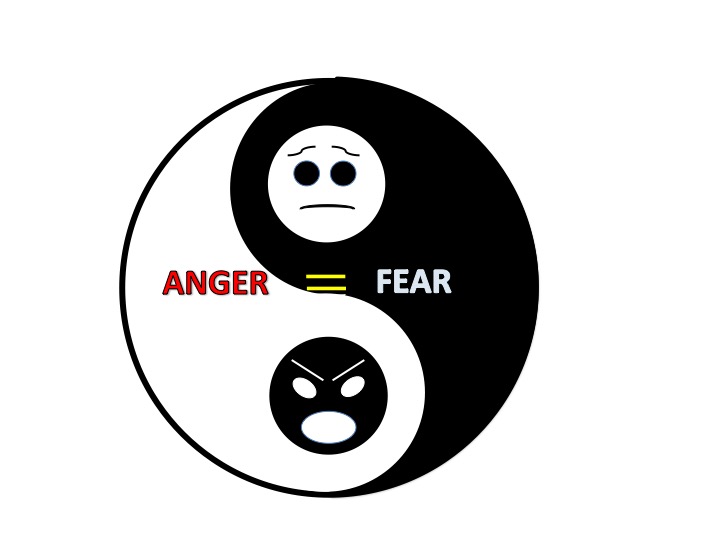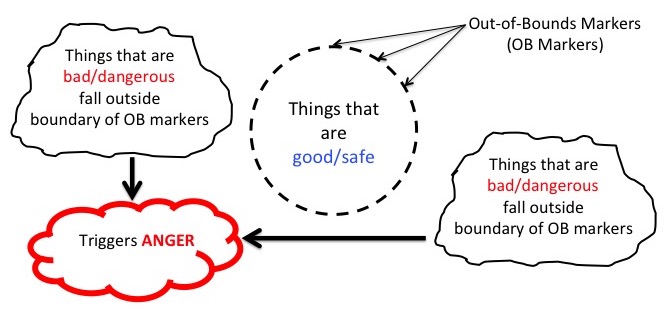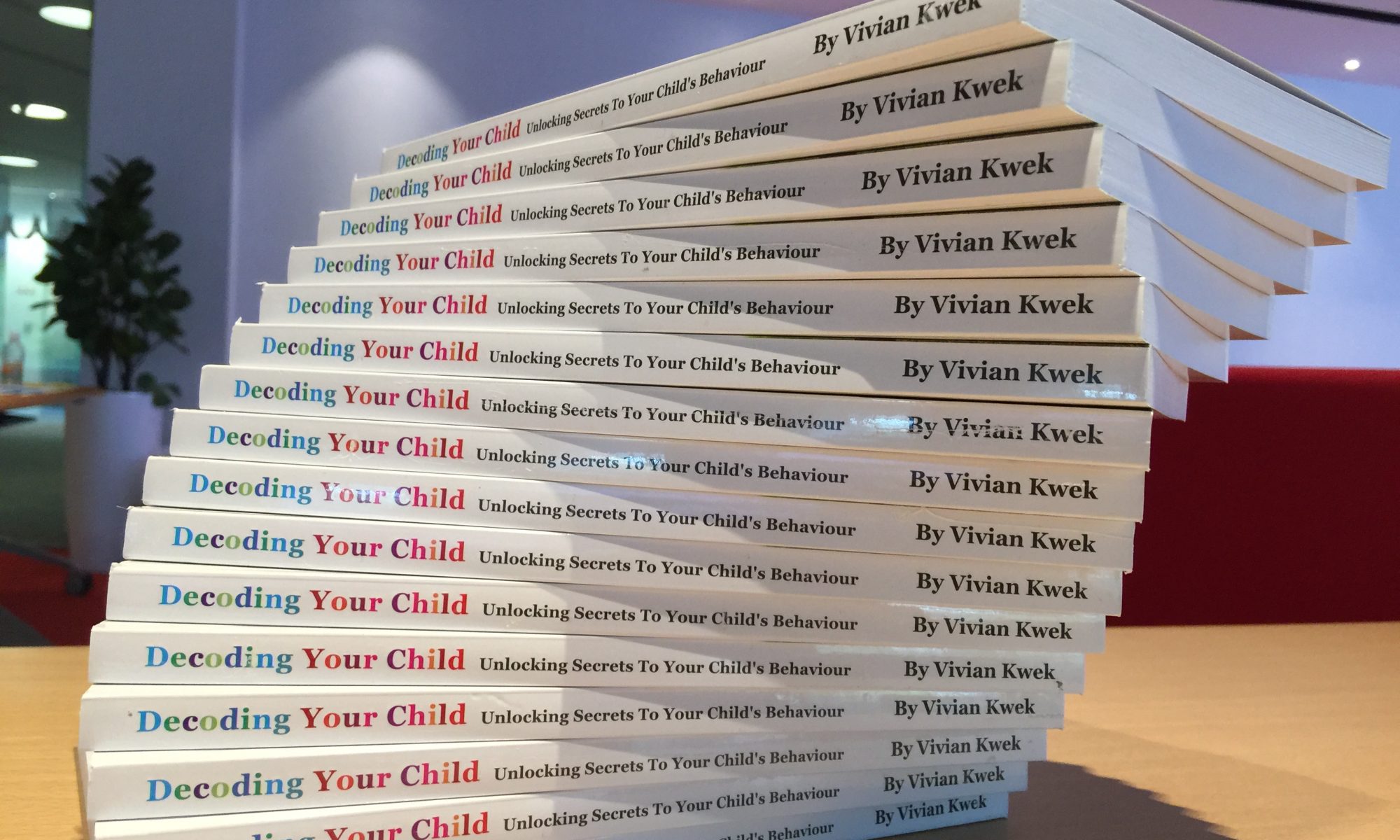We have previously looked at the “WHAT” (read Part 1 here) and “WHY” (read Part 2 here) aspects of ANGER.
In Part 3, we will look at the “HOW”. How do we control and deal with our anger?
What We Can Do
1) Identify the Fear
In Part 2 of Dealing with Anger, I mentioned that ANGER is the mask for FEAR.

Whenever we get angry, it’s because a fear is triggered. And instead of feeling paralysed by the fear, we put on our ANGRY mask so we can “fight” the threat. In other words, instead of dealing with the fear, we attack whatever it is that exposes that fear.
What we see on the surface is ANGER (shouting, hitting etc). But beneath that surface is a whole range of other emotions that is almost always backed by fear.
For example, most of us instinctively get angry when someone points out our mistakes. But what do we actually feel? Most probably it was embarrassment. However, the underlying emotion is actually our fear of “losing face”.
Or if someone cuts us off in traffic, we feel indignant that the other driver is being rude and we honk angrily at him. But our underlying emotion could be our fear of being late. It could even be due to our kiasuism (fear of losing) to other driver.
Or if, instead of us, a colleague gets promoted. Some of us may feel jealous. We may complain about unfairness or even resign in anger. But actually what is triggered is our subconscious fear that our contribution is not being recognised by our bosses.
Of if our child throws a tantrum. Out of frustration, we yell, shout or hit the child. But if we analyse it further, it could be our fear of not knowing how to help our child. I know some parents fear becoming the parent they vowed never to be. I was one of them. It took me a long time to overcome that fear. I’ll share how I overcome that in a moment.
The point is whenever we get angry, there actually lies a host of emotions (frustration, jealousy, embarrassment etc) beneath that ANGER. And if we dig further, those emotions always stem from fear.
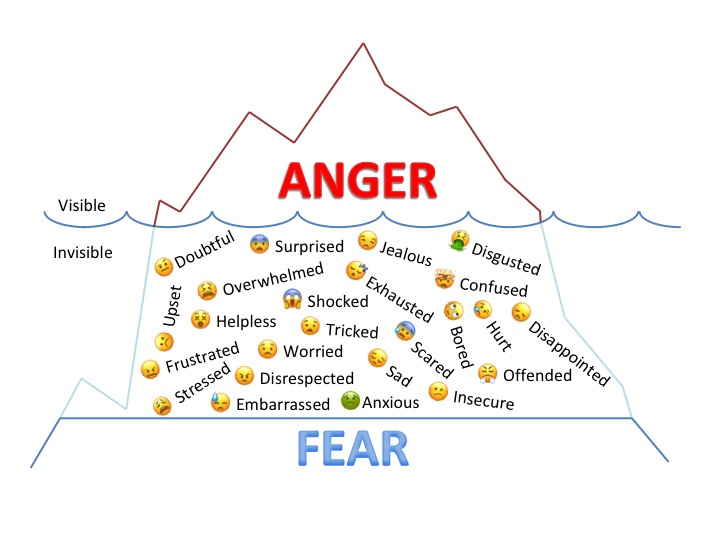
How does knowing that help us?
Every time we feel angry, even if we have already exploded, we need to take the time to reflect and identify the emotion that triggered that anger. More importantly, we must identify the fear that is triggered. After a while, we will discover certain fears keep surfacing.
2) Identify the Fear Pattern
What are the fears that keep surfacing? Is it the fear of “losing face”? Why are we afraid of losing face? Is it because we are worried people will think/know we have FAILED to do it right?
Or is it kiasuism, our fear of losing? Why are we afraid to lose? Is it because we don’t want to appear lousier than others? Because that would mean we have FAILED to win?
Or is it the fear of becoming someone whom we have vowed never to become? Why is it fearful to become that person? Is it because we know that person is flawed and if we are becoming like them, it means we too are flawed, that we have FAILED at being better?
Or is it fear of the unknown, fear of change? Why is change or the unknown so fearful? Is it because we don’t know how to respond or deal with it, that we will FAIL to adapt?
We need to keep asking questions and drill as deeply as possible to uncover our hidden fears.
Most of the time, we will realise our root fear is the fear of failure. And that comes from our fear of being NOT GOOD ENOUGH.
3) Question the Validity of the Fear
The fear of failure is deeply entrenched in our psyche, especially in our culture. We were brought up in a society where failure, or making mistakes, is frowned upon and not seen as an essential step towards learning. Some of us were brought up where we were not given second chances, or were very harshly punished for our mistakes.
I used to beat myself up badly every time I messed up. I would feel guilty, and with each loss in my temper, I would feel more inadequate then ever. Not only did I feel I wasn’t GOOD ENOUGH, I actually felt I was worse than the parent I did not want to become. Why? Because, compared to my parent, I had done so much reading and studying about becoming a good parent. Yet I had failed to do what I wanted to do. I was convinced I was a lousy, terrible, unworthy parent to my children.
Until one day, I had an epiphany.
I used to have a parent who would punish me when I messed up. Not only did I get a tongue lashing, I would get a physical lashing as well. Even if I had scored 97 marks in my Math test, I would receive 3 lashings for not scoring 100. And if I scored 99, then it would be 1 very hard lashing, because I was SO CLOSE yet not achieve 100. I remember scoring 77 marks once. Those were dark days… I was brought up to fear failure, to fear mistakes.
What led to my epiphany was I realised I hadn’t been scolded nor received lashings for more than 30 years. Yet that blueprint of being whipped and lashed had been so ingrained in me that I had became my greatest punisher. I realised I was the one who had made my life extremely difficult especially when my journey was rough. I had become my harshest critic to prevent failing or making mistakes. But my harshness sunk me to greater depths of despair whenever I failed and each “sinking” was harder to climb out of. How could I ever be the parent I want to be if I were so lousy?
So I went on a quest to learn how to overcome the conditioning that failure needs to be “beaten” out of me, that I am never good enough, even if I am at 99%.
And this is what I learned on my quest.
We need to really question the validity of our fear of failure. Past failures do not mean future failures, otherwise none of us would have ever learned to walk, ride a bike, swim, or do almost anything. How many of us learned to do anything the very first time we did them? Most of us had failed repeatedly before we succeeded in doing anything well. Yet, because we had persevered, each failure helped us learn where we went wrong and we became better.
So instead of saying we are not good enough, or that failure is bad, a strong mantra or affirmation we can use is this:
“I am doing the best I can given the circumstances I am in with the knowledge and skills I have.”
“Failure and learning from past mistakes are necessary for growth and success.”
That way, we don’t beat ourselves up when we have yet to reach success. We will have the strength to pick ourselves up, learn, and have another go until we get it right.
These mantras have helped me so much in managing my “failures”, in helping me pick myself up and learn to be better. They have empowered me to feel I CAN be better and they did not sink me into the depths of despair.
It sounds simple, but actually takes a lot of courage and resilience to press on and not get buried by mistakes. When the going got tough, and it frequently did and still does, I just thought about Thomas Edison. When asked how he felt failing 10,000 times before he invented the lightbulb, he replied, “I have not failed. I’ve just found 10,000 ways that won’t work.”
The key here is to know we can do it and keep working on finding a solution without beating ourselves up.
BUT some parents tell me, “I can’t control my explosions! Even before I can analyse my fear, my anger has already gripped me and I have exploded. So how?”
4) BREATHE!
When we feel that familiar gush of anger flooding into our system, the very first step is to take a deep breath. It takes conscious effort and determination to not let the anger control us. The wonder of taking that ONE deep breath is that most people will find their brains less foggy and they can think better after that one deep breath . It is through this first step that anger can be controlled.
Unfortunately, that is one of the hardest thing to do. I have encountered so many parents who say that once they are gripped by anger, they would lash out instinctively. They only remember they need to take a deep breath after their anger is spent. Why?
Usually when an EVENT happens, we have a THOUGHT or interpretation about it. That THOUGHT triggers us feel a particular EMOTION which leads to a certain BEHAVIOUR. For example, the child hits his sibling. Automatically, our brain interprets that event with the thought that the child is being naughty which makes our blood boil (anger) and we yell at or hit the child

The thing is, whenever we allow a thought to be triggered by a particular set of events and we respond with a particular emotion which leads to certain behaviour, our brain triggers a connection from the event to the interpretation (thought) to the corresponding emotion and finally to the behaviour. The more we react to the same event by pulling up the same thought followed by the same emotion and reinforcing it with the same behaviour, the thicker and stronger the synapse (or pathway) from the event to the final behaviour becomes.

It gets to the extent that the pathway becomes “instinctive”. In other words, the final behaviour becomes instinctive whenever the interpretation or thought appears as a result of certain events. The link (arrow) from EVENT to BEHAVIOUR as well as from THOUGHT to BEHAVIOUR is now very strong and thick.

That is why some parents cannot even stop to breathe once the trigger is activated. That is why for many parents who have “anger management” issues, they cannot even remember to breathe once they feel angry.
So How?
Does that mean there is no cure once we have anger management issues? Thank goodness that is not the case. There is a cure. Otherwise I would still be having anger management issues.
I used to be an explosive mom. Despite knowing and doing my best to practice loving guidance, I had on many occasions yelled at my two older children when they were young. And even though it was rare, I have also been guilty of spanking them.
That was years ago before I learned about anger and why I exploded. With that knowledge and a lot of hard work (and mistakes), I overcame that “instinct” to yell at them and was also able to stop myself from raising my hands to their bottoms.
I have 3 children. My older two are 10 and 8 years older than my youngest child. They have often commented that their youngest sibling has a very different mom. Even though they have not been yelled at or hit for years, the trauma of how I had “disciplined” them with violence still remained.
That is why I strongly advocate for peaceful, loving discipline. Our children remember how we treat them, even if they may have forgiven us.
Visualise It Now
So how did I overcome my anger? It was through visualising what I would do when the “event” occurs.
Let us do a few simple exercises now.
Take two deep breaths slowly (BEHAVIOUR 1). Now visualise yourself calming down and creating the THOUGHT that your child needs your help. Then bring up the feeling of compassion and imagine yourself talking gently and lovingly with your child. You can even think of the “script” you would say to the child when you are calm (BEHAVIOUR 2).

Keep replaying that visualisation over and over again.
Why would that help? It helps because our brain cannot differentiate between what is real and what is imaginary. It will still form synapses. Hence, when we visualise or imagine something, our brains will still trigger the connections. In other words, we can actually “rewire” our brains just by thinking!
The more we visualise ourselves doing this, the stronger the pathway (arrow).

If you can, keep repeating this visualisation several times a day. However, I shall be brutally honest here. After doing the exercise now (assuming that you have done it), most parents will most likely repeat this visualisation only when they explode the next time and feel guilty. They will remember they WERE SUPPOSED to take 2 deep breaths.
Instead of feeling guilty that you did not take 2 deep breaths but had exploded, just do your visualisation. Imagine yourself taking 2 deep breaths, creating the thought that your child needs help and you feeling compassion for him.
Then go through the script where you will speak gently and lovingly to him. Keep doing this EVERY TIME you explode. Do not give in to the guilt and replay how you have exploded. Otherwise you are reinforcing the synapse of you responding to events or behaviour of your child with anger. Stop the video of your mistake. Create a new video of you taking 2 deep breaths, calming down etc. Trust me, it works. It takes time and effort because we are rewiring our brain, but it works.
How do you know you have mastered “Taking 2 Breaths”?
When you feel irritated or frustrated, but not angry yet, you will find yourself taking the 2 deep breaths, feeling calmer and being better able to speak gently and lovingly.
You may also notice your explosions getting fewer in frequency and lesser in intensity. Your synapse below is ready.

When that happens, you are ready for Step 2.
What is Step 2?
Step 2 requires you to rewire events that make you feel your child is being naughty or intentionally making you upset.
Think about something your child does that typically causes you to explode. Imagine that she has done that. Now visualise yourself taking two deep breaths and calming down.

Keep doing this visualisation while practicing you taking 2 deep breaths, thinking and believing that your child needs help and you speaking gently and lovingly to her. Keep doing this until it becomes your default behaviour.
Once you can get from whatever triggers you (big or small) to taking your 2 deep breaths, the rest of loving guidance will follow.
Step 3
What? There is still Step 3?
Well, I never said changing our habitual instinctive behaviour is easy, did I? It takes effort and we need to cover different scenarios because right now the more easily triggered we are by anger, the more “roads” we have in our brains that lead to “Rome”. So we need to “destroy” those traditional paths and recreate new roads that lead to paradise.
So what is Step 3?
It is catching ourselves having the thought that our children are naughty. Whenever we have that thought, catch it and visualise ourselves taking 2 deep breaths. We want to create a strong pathway for this negative thought and link it to us taking 2 deep breaths.

When we find ourselves successfully catching ourselves referring to or thinking that our children are naughty and following that thought with 2 deep breaths, we would have succeeded in creating and strengthening these new pathways in our brain and weakening our old paths.
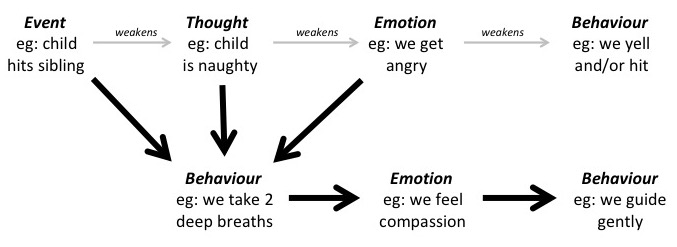
I have a few parents who confessed they would still scold and spank after they take their 2 deep breaths. The reason that happens is because their visualisation practice laid out in first part of the exercise (visualising taking deep breaths followed by the thought that their child needs help, followed by the feeling of compassion which leads them to be able to speak gently and lovingly) was not strong enough.
Good News!
This manner of rewiring our brain applies not only to anger management. It applies to all aspects, including getting rid of procrastination, overcoming fear, etc. The more vivid we can visualise what we would like happen, the faster and thicker the connection will grow and the sooner we will be able to exhibit the desired behaviour.
That is why our thoughts have power. When we keep replying old “videos” in our heads, feeling the same shame and guilt for our angry explosions, we are actually strengthening those undesirable explosions!
Instead of feeling shame, guilt and regret, play a different video, one where we do the right thing and say the right thing. Just keep replaying that video. It would be more productive in helping us change our behaviour.
Conclusion
I hope you have enjoyed the 3-part series of Dealing with Anger. We have looked at WHAT anger is, WHY we choose to react with anger, and HOW we can deal with anger. In my next post, I will share a little more about why teaching and disciplining with love is more productive and effective than teaching and disciplining with fear.
If you have found this blog helpful to you, do share it with your friends! Thank you.
Happy Parenting!!
Update: You can read the first two parts of the Dealing with Anger series here:
Part 1: What is Anger
Part 2: Why We Choose Anger

